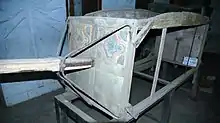Siviyar
Siviyar (Tamil: சிவியார், lit. 'Chiviyar', also written Chiviar and Tamil: சிவிகையார், lit. 'Chivikaiyar') is a caste found in the Indian state of Tamil Nadu and Sri Lanka.[1] They were traditionally palanquin bearers. They are a single community in Sri Lanka, but are however a subcaste of the Idaiyar caste of Tamil Nadu.[2]
| Siviyar | |
|---|---|
| Religions | Hinduism |
| Languages | Tamil |
| Related groups | Idaiyar, Tamils, Sri Lankan Tamils |
Etymology

The name is derived from the Tamil word Civikai meaning "palanquin" and the suffix -ar denoting honorific plural.[3][4] The headmen of them were known as Kūriyan, meaning "proclaimer", in reference to his proclaiming or announcement of the titles of the person whom he carries before the palanquin.[5][6]
History
.jpg.webp)
The Siviyars worked under the kings of Jaffna Kingdom as palanquin bearers, woodcutters and water carriers.[7] After the fall of Jaffna Kingdom, were the Siviyars under Dutch Ceylon serving as palanquin bearers under the Commanders and Dissavas, and were a influential class in Jaffna, who also held titles such as Mudaliyars.[8][9] They are divided into three traditionally endogamous subcaste or labour groups; adikke-Siviyar, uppu-Siviyar, and arisi-Siviyar. The adikke-Siviyars are involved in ingraining wheat and curry-powder. The uppu-Siviyar are involved in salt making, and the arisi-Siviyar in rice cultivation.[10]
The Siviyars of Tamil Nadu migrated from Mysore region to Tamil Nadu during the reign of Tipu Sultan.[11]
Several from this caste were strongly represented in the Liberation Tigers of Tamil Eelam.[12]
See also
References
- Singh, Kumar Suresh (1996). Communities, Segments, Synonyms, Surnames and Titles. Anthropological Survey of India. p. 1130. ISBN 9780195633573.
- Thupston, Edgar (1909). Casstes and Tribes of Southern India. Government Press. p. 391.
- Glossary of Native, Foreign, and Anglicized Words Commonly Used in Ceylon in Official Correspondence and Other Documents. Asian Educational Services. 1996. p. 11. ISBN 9788120612020.
- Wilden, Eva (2006). Literary Techniques in Old Tamil Caṅkam Poetry: The Kuruntokai. Otto Harrassowitz Verlag. p. 101. ISBN 9783447053358.
- Winslow, Miron (1989). Winslow's a Comprehensive Tamil and English Dictionary. Asian Educational Services. p. 352. ISBN 9788120600003.
- Knight, Joseph; Spaulding, Levi (1844). An English and Tamil dictionary: or, Manual lexicon for schools. Giving in Tamil all important English words, and the use of many in phrases (in Tamil). American Mission Press. p. 585.
- Lach, Donald Frederick; Kley, Edwin J. Van (1998). Asia in the Making of Europe. University of Chicago Press. p. 993. ISBN 9780226467672.
- Arasaratnam, Sinnappah (1 January 1996). Ceylon and the Dutch, 1600-1800: External Influences and Internal Change in Early Modern Sri Lanka. n Variorum. p. 384. ISBN 9780860785798.
- Tambiah, Henry Wijayakone (2001). The Laws and Customs of the Tamils of Jaffna. Women's Education & Research Centre. p. 94. ISBN 9789559261162.
- Bruland, Stine (2015). "Re-creating meaning in a Tamil family after war and migration". Underneath the Margosa Tree. Norwegian University of Science and Technology: 65.
- People of India: A - G. Oxford Univ. Press. 1998. p. 3305. ISBN 9780195633542.
- Premdas, Ralph R. (1993). The Enigma of Ethnicity: An Analysis of Race in the Caribbean and the World. University of the West Indies, School of Continuing Studies. p. 297.